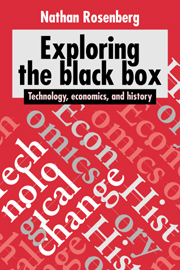Book contents
- Frontmatter
- Contents
- List of figures
- Preface
- Introduction
- Part I Dealing with an uncertain future
- Part II Technology in context
- 5 Economic experiments
- 6 Why in America?
- 7 Can Americans learn to become better imitators?
- 8 Critical issues in science policy research
- Part III Sectoral studies in technological change
- Index
8 - Critical issues in science policy research
Published online by Cambridge University Press: 12 November 2009
- Frontmatter
- Contents
- List of figures
- Preface
- Introduction
- Part I Dealing with an uncertain future
- Part II Technology in context
- 5 Economic experiments
- 6 Why in America?
- 7 Can Americans learn to become better imitators?
- 8 Critical issues in science policy research
- Part III Sectoral studies in technological change
- Index
Summary
Everyone knows that the linear model of innovation is dead. That model represented the innovation process as one in which technological change was closely dependent upon, and generated by, prior scientific research. It was a model that, however flattering it may have been to the scientist and the academic, was economically naive and simplistic in the extreme. It has been accorded numerous decent burials, and I do not intend to resurrect it only to arrange for it to be interred once again.
However, in a world in which the economic role of science may reasonably be expected to grow over time, and in which policy-making will need to be based on a more sophisticated understanding of the ways in which science and technology interact and influence one another, a better road-map of the science/technology landscape is vitally necessary. I will therefore not be primarily examining the determinants of innovation. Rather, my main focus will be on some of the ways in which the two communities, of scientists and technologists, exercise influences on one another.
Obviously, while my central focus will not be on the determinants of innovation, what I say will, I hope, be highly relevant to that question. Indeed, I regard it as central to a more useful framework for analyzing the innovation process that it should be based on a more sharply delineated road-map of science/technology relationships. That road-map ought, at a minimum, to identify the most influential traffic flows between science and technology. Obviously, such a map cannot at present be drawn.
- Type
- Chapter
- Information
- Exploring the Black BoxTechnology, Economics, and History, pp. 139 - 158Publisher: Cambridge University PressPrint publication year: 1994
- 5
- Cited by



